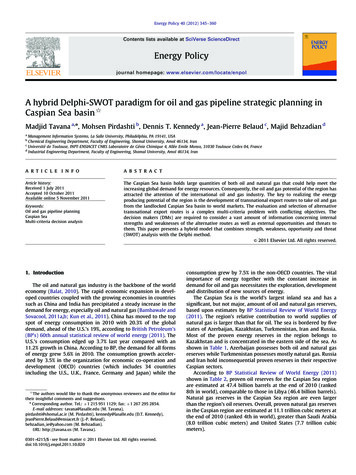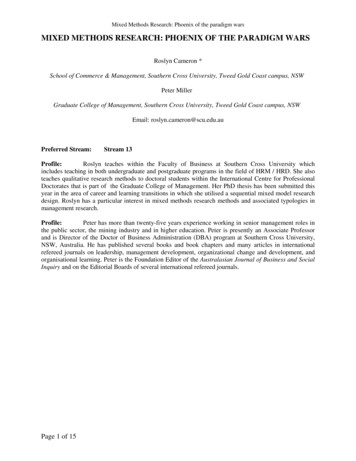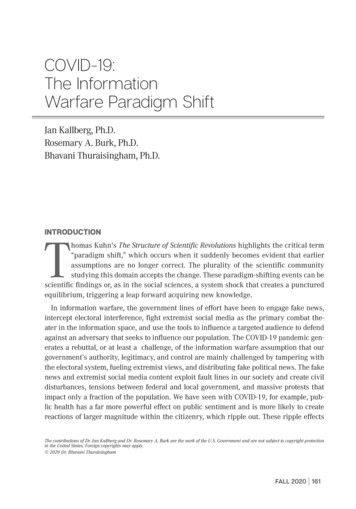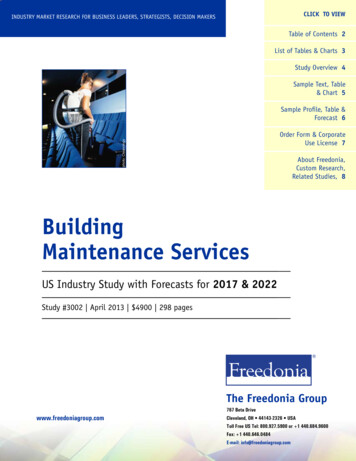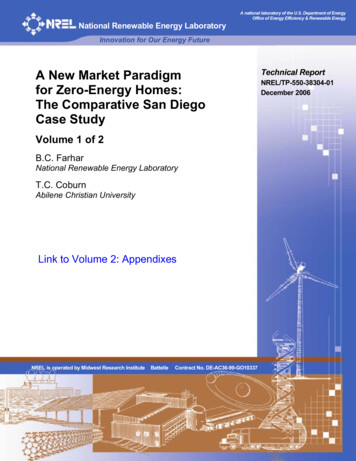
Transcription
A national laboratory of the U.S. Department of EnergyOffice of Energy Efficiency & Renewable EnergyNational Renewable Energy LaboratoryInnovation for Our Energy FutureA New Market Paradigmfor Zero-Energy Homes:The Comparative San DiegoCase StudyVolume 1 of 2B.C. FarharNational Renewable Energy LaboratoryT.C. CoburnAbilene Christian UniversityLink to Volume 2: AppendixesNREL is operated by Midwest Research Institute BattelleContract No. DE-AC36-99-GO10337Technical ReportNREL/TP-550-38304-01December 2006
A New Market Paradigmfor Zero-Energy Homes:The Comparative San DiegoCase StudyVolume 1 of 2B.C. FarharNational Renewable Energy LaboratoryT.C. CoburnAbilene Christian UniversityPrepared under Task No. ZB03.3003National Renewable Energy Laboratory1617 Cole Boulevard, Golden, Colorado 80401-3393303-275-3000 www.nrel.govOperated for the U.S. Department of EnergyOffice of Energy Efficiency and Renewable Energyby Midwest Research Institute BattelleContract No. DE-AC36-99-GO10337Technical ReportNREL/TP-550-38304-01December 2006
NOTICEThis report was prepared as an account of work sponsored by an agency of the United States government.Neither the United States government nor any agency thereof, nor any of their employees, makes anywarranty, express or implied, or assumes any legal liability or responsibility for the accuracy, completeness, orusefulness of any information, apparatus, product, or process disclosed, or represents that its use would notinfringe privately owned rights. Reference herein to any specific commercial product, process, or service bytrade name, trademark, manufacturer, or otherwise does not necessarily constitute or imply its endorsement,recommendation, or favoring by the United States government or any agency thereof. The views andopinions of authors expressed herein do not necessarily state or reflect those of the United Statesgovernment or any agency thereof.Available electronically at http://www.osti.gov/bridgeAvailable for a processing fee to U.S. Department of Energyand its contractors, in paper, from:U.S. Department of EnergyOffice of Scientific and Technical InformationP.O. Box 62Oak Ridge, TN 37831-0062phone: 865.576.8401fax: 865.576.5728email: mailto:reports@adonis.osti.govAvailable for sale to the public, in paper, from:U.S. Department of CommerceNational Technical Information Service5285 Port Royal RoadSpringfield, VA 22161phone: 800.553.6847fax: 703.605.6900email: orders@ntis.fedworld.govonline ordering: http://www.ntis.gov/ordering.htmPrinted on paper containing at least 50% wastepaper, including 20% postconsumer waste
PrefacePrefaceThis study was built from the ground up. Its foundation is the pilot work in the field withSheaHomes staff, the advisory committee, and the homeowners. This study is not an engineeringand economic analysis. It is a statistical, empirical analysis of the homes at the Scripps Highlandsdevelopments in San Diego that involved observation and qualitative interviews with thehomeowners, SheaHomes’ professional staff, and the staff of the utility company (San Diego Gas& Electric).Early findings have been published previously in three papers presented at the American Councilfor an Energy Efficient Economy Summer Study in 2002 and 2004. Not all the findings from thepreliminary qualitative pilot work are included here.The Home BuilderSheaHomes was the innovator in this project. The company took the risk of using newtechnologies in its homes. Its staff was incredibly generous in sharing information with us aboutwhich homes were planned as PV standard and which were PV eligible. We spent time at thesales center taking virtual tours of the homes, observing, and reading informational materials.The builder also shared with us a contractor’s study of the media coverage and videos ofcoverage on the evening news in the San Diego area.SheaHomes also provided a list of people who had visited the Scripps Highlands sales center butwho did not buy homes. We did a separate analysis (called the “lost lookers” study) to follow upon their experiences.The HomeownersThe homeowners were also very generous and patient with our surveys and interviews, eventhough they had been subjected to a good many of both before we had a chance to talk to them.We asked SheaHomes owners to tell us their stories. We asked them: “Please tell us the story ofhow you came to buy your home,” with many probes and follow-ups. We also asked them to tellus about living in their new homes. If they did not bring up their homes’ energy features (whichthey often did not), we brought up the subject and asked them to show us these features. This wasimportant because we could then determine what they knew about them and if the energy featuresmattered to the homeowners.We visited 25 highly energy-efficient homes with solar water heating, both with and withoutsolar PV, and looked at the solar water heating panels, the temperature of the water coming intothe water heaters, the PV panels, the air-conditioning units, the refrigerators, dishwashers,windows, and thermostats. We also looked at utility bills and spreadsheets that somehomeowners maintained to track their energy use. Some homeowners showed us compactfluorescent lights (CFLs) that they had installed in their kitchens after move-in.vii
The UtilityWe met with staff at San Diego Gas & Electric Company in San Diego to discuss the study, theutility analysis, and the requirements for accomplishing the transfer of data with homeownerpermission. The staff described their experiences in net metering and interconnectivityagreements with residential customers.The approach of building the quantitative study, which is the subject of this report, on earlierqualitative field work is a highly reliable method. The relevance of survey questions, theirexhausting the range of potential responses, and the mutual exclusiveness of the responses helpto assure an interpretable set of findings. The cooperation of SheaHomes, the homeowners, andall of the organizations who helped us was invaluable. We hope the results warrant the trust andconfidence they have invested in us.Any errors in this report are the responsibility of the authors.viii
AcknowledgmentsLew Pratsch of the Building Technologies Program, U.S. Department of Energy, Washington,D.C., was the Program Manager for the study.The National Renewable Energy Laboratory (NREL) was advised in this study by a studyadvisory group. The following individuals served on the study advisory group and contributedtheir insights to this project: Scott Anders, then at the San Diego Regional Energy Office; now at the Energy PolicyInitiative Center, University of San DiegoTom Bohner, Sun Systems, Inc.Jonathan Done, then at SheaHomes, San DiegoRob Hammon, ConSol, Inc.Russ Hewett, National Renewable Energy LaboratoryLes Nelson, California Solar Energy Industries AssociationMarc Roper, then at AstroPower, Inc.; now at Schott SolarTeri Shusterman, SheaHomes, San DiegoRyan Green, formerly on the SheaHomes-San Diego staff and now at Centex Homes, San Diego,also provided valuable insights to the study.Extensive assistance to the study was provided by other SheaHomes’ staff in San Diego,including, among others, Diane Rivera, former Director of Marketing; Pattie Walker, formerDirector of Sales; and Pam Beaird, Sales Agent.Bob Keithly of San Diego Gas & Electric Company (SDG&E) coordinated the company’sprotocol review for the utility release forms and utility consumption and cost data for customersagreeing to have their utility records released to NREL for inclusion in the study’s analysis.SDG&E also provided utility records to NREL in electronic form for the accounts that hadformally released their data.The late Nancy Collins of Q4 Associates, Oakland, California provided invaluable consultingassistance during the qualitative phase of the study, and was also principal investigator of the“Lost Lookers” study.In addition, the Building Industries Institute of California contributed 4,000 to the ColoradoEnergy Science Center (CESC) to provide 10 financial incentives for homeowners in theuniverse of study to encourage them to respond to the mail questionnaires. With this assistance,and with the help of Pat Keegan (CESC director), it was possible to achieve the response ratesaccomplished.ix
The participation of the many homeowners who took their time to respond to the questionnairesthey were sent is acknowledged and is very much appreciated.The report was peer reviewed by the study advisory group who provided numerous helpfulsuggestions and comments. All errors are the responsibility of the authors.Don Hagengruber, NREL’s Chief Counsel, provided extensive support and oversight in theHuman Research Review process. The Human Research Committee of the University ofColorado-Boulder served as the Institutional Review Board (IRB) and reviewed and approved theprotocols used in this research.Ron Judkoff, Director, Center for Buildings and Thermal Systems, NREL, provided unflaggingsupport throughout this effort. Tim Merrigan, NREL, was the NREL Program Manager for thisstudy. Jay Burch and Ron Judkoff, Center for Buildings and Thermal Systems, NREL, providedtechnical assistance to the statistical analysis comparing electricity and gas consumption andutility costs between the high performance and comparison homes. Megan Murphy, doctoralcandidate, Department of Sociology, University of Colorado, Boulder, Colorado, providedextensive research assistance to Dr. Farhar. A. J. Sterling, student at Abilene ChristianUniversity, provided research assistance to Professor Coburn.Co-editors of the report provided yeoman efforts; they were Stefanie Woodward and NancyWells. Kay Vernon provided superior word-processing expertise. Diane Littau assistedmanuscript preparation in a variety of ways.The authors would also like to acknowledge Susan Sczepanski, NREL, for excellent graphics for the study’s questionnairesFay Hoover and the NREL Copy CenterAlexander’s Data Services, Inc., for data entry and cleaning.x
Executive SummaryIntroduction and Background“It’s good for society.”In April 2001, SheaHomes began to offer high-performancehomes at Scripps Highlands in San Diego, California. Thiswas the first such offering in the United States by aproduction builder. The 306 homes, sold by November2003, were highly energy efficient; 293 had solar waterheating systems; and 120 had photovoltaic (PV) systems.- This and other quotes are fromcomments made by owners in theSheaHomes Scripps Highlandscommunities.The National Renewable Energy Laboratory (NREL) used a diffusion-of-innovations theoreticalperspective to follow this development over time. The study focused on the builder experience,market response to high-performance homes, increases in home values over time, and theconsumption and cost of electricity and gas in the high-performance and adjacent comparisonhomes.We began our work by meeting with a project advisory group to define key research questions.During the first, qualitative phase of the study, we conducted numerous interviews of executivesand staff of SheaHomes, organizations partnering with the builder, and other interested parties.Field work was conducted at the SheaHomes community with early buyers and lost lookers.Researchers collected background information on the home sales processes. Qualitativeinterviews focused on the homeowners’ reasons for purchase and their perceptions of the energyfeatures of their new homes. In this early phase, a total of 43 respondents in 25 households wereinterviewed; the information obtained was used to formulate questions for a more extensivesurvey of all homeowners.We also selected a comparison community of 103 homes built by a different builder of similarvintage, size, and price adjacent to San Angelo and Tiempo. Although they were built to Title 24building codes, thus providing more energy efficiency than conventional building codes in otherstates, the comparison homes were offered with no special energy or solar features standard.The quantitative phase consisted of a comprehensive mail survey and detailed statistical analysisof the responses from SheaHomes and comparison homeowners. Questionnaires were mailedearly in 2004 to all homebuyers. The overall survey response rate was 63% (65% from theSheaHomes communities and 56% from the comparison community). The survey addressedperceptions and preferences of the new homebuyers and the roles, if any, that energy played intheir home purchase decisions. The survey also examined homebuyer satisfaction, willingness topay for solar PV, preferences about energy policies, experiences with the homes, aesthetics ofsolar PV, satisfaction with utilities, and demographics, including environmentalism andinnovativeness.Respondents were asked to sign release forms for SDG&E to provide data on electricity andnatural gas consumption and costs. The utility company provided the data to NREL, whichperformed analyses to determine if statistically significant differences in energy consumption andxi
energy costs can be attributed to the energy efficiency and solar features of the high-performancehomes. These analyses controlled for an annual usage cycle, climate, square footage, number ofoccupants, and other variables. This unique research opportunity gave us the chance to putconventional wisdom about ZEH markets to the test; the detailed findings from our study arecontained in this comprehensive 800-page report.Home Sales PricesHigh-performance homes are competitive on the market. Based on actual sales data, per squarefoot, they sold for 9.2% less than comparison homes of the same vintage, on average. Thisdifference, though small, is statistically significant. When house size is controlled for, thedifference remains. Thus, even when controlling for the fact that housing prices per square footdecrease with house size, we find that the SheaHomes were competitively priced.Uptake of Optional PV Systems“It’s best to integrate the solar electricUltimately, 120 of the 306 SheaHomes weresystem into the entire home purchase rathersold with some sort of PV system. Hence, 39%than having it offered as an option in awere sold with PV systems and 61% were not.piecemeal way. It should all be rolled intoHowever, only 260 homes were PV-eligible;the overall price.”hence, 46% of these were sold with PVsystems. Clearly, the uptake on optional PVequipment was not as strong as it might havebeen. A total of only 12% of all PV-eligible homes were sold with PV systems optionally. Mostof the PV systems sold came standard.However, we believe the lackluster sales ofoptional PV systems was the result of sales“We feel the builders know what they arestaff failure to offer the optional PV systemsdoing, so if they offer the solar as part ofto buyers of PV-eligible homes. In fact, ourthe package, there must be a reason.”data show that a majority (56%) of those whocould have purchased optional PV systemswere not told about the option. Thus,the uptake rate is not 12%, but 44% of those actually offered the PV systems. Homebuyers reliedheavily on sales staff for information about PV systems, and staff were more concerned aboutclosing home sales and less focused on sales of PV systems that might complicate the deal. Staffreceived no extra compensation for sales of PV systems.Who Are These Homebuyers?The buyers of high-performance homes and the buyers of new conventional homes share thesame characteristics. SheaHomes and comparison homebuyers brought virtually identicalattributes to their home purchase decisions, such as demographics, environmental attitudes, andearly adopter characteristics.xii
As expected, residents of both communities mostly represent upper-middle class married coupleswith children, or mature couples. They are relatively affluent with well-paying occupations.Fifteen percent more of the SheaHomes owners (19%) than of the comparison owners (4%) enjoyan annual income of more than 200,000. Yet, because SheaHomes’ sales prices werecompetitive, higher income would not have influenced their decisions to buy there. Nodifferences between SheaHomes and comparison homebuyers are found in results on measures ofearly adopter characteristics or environmentalism.Three-quarters of the buyers visited both the SheaHomes and comparison communities whenthey were shopping for new homes. However, neither group was well informed about homeenergy features, although buyers of SheaHomes knew a bit more at the time of purchase. Amajority of the comparison buyers were unaware that they featured energy efficiency and solarenergy, even though they may have visited SheaHomes.Variables on which the types of homeowners differ were by and large those affected by theirexperiences in living in their new homes (survey data were collected after owners had lived intheir new homes for at least six months). For example, six in ten of SheaHomes owners agreethat solar water heating systems are cost effective, and half of SheaHomes owners agree thatsolar PV systems are cost effective. The corresponding percentages of comparison homebuyersare 40% and 36%, respectively.Despite some difficulties with interconnectivity issues, owners of SheaHomes with PV systemshave more positive attitudes toward SDG&E than other homeowners. These differences aresignificant. A majority of PV homeowners are pleased with SDG&E’s billing processes.Similarly, almost one-third of PV owners believed that electricity rates had come down sincethey moved in, compared with 18% of SheaHomes owners without PV systems.It is not the qualities the homebuyers brought to thehome purchase decision, but rather the experience of“We isolate things to see what thePV ownership that changes attitudes and perceptions.electricity hogs are. We’re alreadyIt also seems to change energy behavior. Living inmore energy conscious because of thehighly energy efficient homes with solar water heatingfeedback device.”and PV systems promotes increased familiarity withand interest in those systems, which ultimately leadsto heightened awareness of household energypractices. The behavioral interaction of consumerswith PV technology based on the digital display of kWh production and consumption—and tosome extent the electric meter—provides feedback that seems to affect homeowner energybehavior. Feedback may be significant in bringing about behavioral changes that optimize energyand cost savings. To a limited degree, the PV owners also seem more sensitive than others tosavings from solar water heating systems, even though these have no feedback devices.xiii
Aesthetics and Resale ValueRegarding aesthetics—Neither qualitative nor quantitative data“Huh?”identified aesthetics as barriers to purchaseof homes with solar panels. However,“Satellite dishes are more offensive.”because we primarily studied homeownerswho bought such homes, we cannotconclude that no one objects to theaesthetics of solar panels. It seems fair toconclude that the new homebuying market is large enough that it does not matter if some peopleobject; in fact, home sales at Scripps Highlands were brisk.Similarly, based on our data, any concerns about solar panels diminishing resale value appearunwarranted. In the first 3.5 years, 13% of the comparison homes were resold compared with 5%of the SheaHomes, suggesting a more rapid turnover of comparison homes. SheaHomesexperienced a mean dollar gain of 55.4% for a mean ownership length of 22.5 months.Comparison homes experienced a mean dollar gain of 44.7% for a mean ownership length of28.1 months. The mean dollar gain per month owned was 14,500 for SheaHomes and 9,300for comparison homes.Home Purchase DecisionsThe most important reasons for purchase for both categories of buyers were the home’s locationin a safe and secure quality neighborhood, the overall home value, and the investment potential.The relative rankings of reasons for purchase were the same for both categories of homebuyers.Concerns about the San Diego 2001 electricity crisis did not influence home purchase decisions.Energy was not an important factor in the purchase decisions of most of the study’s newhomebuyers. The reputation of the builder was more important to SheaHomes than tocomparison buyers. Buyers who were more concerned about their residential energy consumptionwere more likely to buy SheaHomes than comparison homes. Every home feature mentioned inour study had a higher average importance rating for those who did not purchase PV homes thanfor those who did, suggesting that home characteristics other than energy features were moreimportant to those not purchasing homes with PV systems.The findings on willingness to pay (WTP) more for PV systems suggest that 5,000 may be athreshold for 1.2 PV systems. More than one-third of non-PV-purchasing homebuyers indicate aWTP at least 5,000 more for PV systems that could replace 50% to 70% of their electricityneeds. This level of savings would require a larger PV system. SheaHomes buyers who upgradedfrom 1.2 to 2.4 PV systems paid an additional 4,000; those who purchased optional 1.2 PVsystems paid 6,000 (later raised to 7,000). Those who purchased optional 2.4 PV systems paid 10,000 (later raised to 11,000). Reasons for not purchasing PV systems tend to center aroundthe expense. Subsidies and amortization would be required to permit installation of larger 2.4 to3 PV systems that would be needed to reduce electricity costs by 60% to 70%.xiv
Satisfaction“When people come to visit, the first thingMost buyers are satisfied with their newwe do is show them the solar equipment.”homes, but SheaHomes buyers, and especiallybuyers of homes with PV systems, are moresatisfied than are comparison buyers. Asignificantly higher percentage of SheaHomes owners than owners of comparison homes (77%versus 67%) indicate they would buy the same houses again. Although this would not be the onlyfactor affecting satisfaction, the comparison homeowners report significantly higher monthlyutility bills than do the SheaHomes owners. Both sets of homeowners find their homescomfortable, but comparison buyers pay higher utility costs to maintain their comfort levels.Owners of SheaHomes believe their homes are energy efficient.By owners’ estimates, living in PV homes has resulted in significantly lower utility bills thanthose reported by the rest of the homebuyers. Two-thirds of PV owners have bragged to othersabout their utility bills, compared to one-quarter of owners without PV. A majority of PV ownersindicate their expectations for utility bills have been met, compared with less than one-third ofother SheaHomes owners.Three dimensions of advantages of PV ownership result“We brag about our windows.”from factor analysis. The first of these is “altruistic”benefits (such as helping to reduce global warming,helping the local economy, benefitting futuregenerations, and helping to improve local air quality). The second is the financial advantage(such as reduced electricity bills, free electricity once the system is paid for, selling electricityback to SDG&E, and increasing the home’s resale value). Finally, personal satisfaction includesincreased self-sufficiency, being technologically innovative, and feeling good about owning thehome.Policy Preferences“Solar electricity should be available andSheaHomes and comparison owners agreed onaffordable on all housing.”energy efficiency and solar energy policypreferences. For example, 92% of both sets ofhomeowners agree or strongly agree that“builders should build very energy-efficient homes if they cost less per month to own andoperate.” Eighty-five percent of SheaHomes and 81% of comparison buyers agree or stronglyagree that “the federal government should support research on highly energy-efficient homes thatproduce all the energy they use.” Interestingly, majorities of both sets of homeowners agree thatsolar water heating and solar PV systems are desirable innovations for new homes.xv
Are Energy and Costs Saved?SheaHomes advertised that its homes, incorporating “the latest in solar electric home powergeneration, solar water heating, and energy-efficiency technology,” would enable homeowners toreduce their utility bills by 30% to 50% over conventionally built homes. The originalSheaHomes concept has been validated by our utility analysis. Among the homes studied,SheaHomes consume less electricity and gas, on average, than adjacent comparison homes.Similarly, SheaHomes households incur lower utility costs, on average, than comparisonhouseholds. For example, the combined average monthly total utility bill for homes with 2.4 PVsystems is 54% lower than for comparison homes, a result that is statistically significant.A New Market Paradigm“All builders should be doing it.”The value of our study does not lie in describing themotivations of recent new homebuyers, but rather insuggesting a conceptually fresh alternative paradigmfor the building and marketing of new ZEHs. When this paradigm is used, builders, newhomebuyers, and utility companies will benefit. When appropriately applied to business practiceand public policy, this new paradigm will help builders create the sustainable communities sonecessary for our well-being and that of future generations.Conventional wisdom on the markets for ZEHs, relying on a diffusion-of-innovations tradition,holds that ZEHs will appeal only to niche early-adopter markets. It posits that ZEHs cost more tobuild and therefore are more expensive to buy than conventional homes. It would follow thatproduction builders should offer them optionally to buyers with unique motivations, such asenvironmentalism. In this view, ZEH aesthetics (in particular, the solar PV panels) are oftenconsidered barriers to most mainstream homebuyers, and as impediments to resale, negativelyaffecting home values. Conventional wisdom also assumes that mainstream homebuyers aremotivated by economic payback on an incremental financial investment for zero-energy featuresfor which they have opted. Homebuyers’ satisfaction, then, is considered contingent on theperceived payback of energy features.Our results suggest a new market paradigm for ZEHs that appears to stand conventional wisdomon its head. This paradigm, though it originates from the San Diego case study, may be usefulelsewhere in California and in the rest of the country, and, indeed, internationally. The tablebelow captures some of the notions that we have termed conventional wisdom and summarizethe new market paradigm along these same dimensions.The results of this case study suggest that the markets for new housing are essentially equivalentto the markets for ZEHs standard, assuming a policy frame that provides subsidies and builderpricing similar to those in effect when San Angelo and Tiempo were built and sold. However,this does not mean that the diffusion-of-innovations approach is irrelevant to the widespreadacceptance of ZEHs. Rather, the early adopters are the builders, utility companies, and policymakers whose adoption of ZEHs will make these homes available standard to many willinghomebuyers. For us to benefit from ZEHs, the innovative building practices for whichxvi
SheaHomes has led the way and the ZEH-supportive policies for which California is becomingincreasingly famous are the innovations that must diffuse.Market Paradigms for Zero-Energy HomesAttributesConventional WisdomNew Market ParadigmSales PricesZEHs cost more to build thanother homes and are moreexpensive on the market.Quality upscale high-performance homes withmarket appeal can be built by production buildersand sold competitively and profitably, especiallywhere subsidies are in place.UptakeIn new developments, buildersshould offer ZEHs optionally,and only a few will be sold.Builders should offer ZEHs standard; mostbuyers will buy them. In addition, the pace ofsales may well be accelerated over that ofconventional homes.HomebuyersOnly innovators and earlyadopters will buy ZEHs (a verysmall percentage of the market).High-performance homebuyers are ordinarybuyers of new production homes in their priceranges; they have no special demographicattributes; their environmentalism and earlyadopter characteristics are no different from thoseof other buyers; some may, in fact, be “unwittingadopters.”AestheticsAesthetics are major barriers toZEH purchase for most buyersand negatively affect resalevalue.Enough buyers are unconcerned about aestheticsthat they purchase homes with solar panels, atleast in a seller’s market, at an accelerated pace.Resale homes with solar panels have higher valuethan comparison homes.Other than early adopters,buyers of ZEHs would bemotivated by economic paybackfor an incremental financialinvestment for which they haveopted.ZEH buyers, for whom energy features are only“icing on the cake,” may be unaware of anypotential additional financial investment if thecosts of energy systems are built into the homes’sales prices and into their mortgages. In fact,some buyers are “unwitting adopters.” However,buyers are aware of their substantial benefitsfrom reduced utility bills. In this model, financialincentives (e.g., rebates) go to the builder,although buyers may receive income tax creditsor renewable energy credits.Homebuyer satisfaction iscontingent on perceivedpayback of energy features.Owners of high-performance homes with PVsystems perceive three major kinds of benefits:(1) altruistic, (2) financial, and (3) personalsatisfaction. These owners appear to becomeincreasingly satisfied over time as they receivefeedback from their systems, modify theirbehavior, and observe (and brag about) theirutility bills.HomePurchaseDecisionsSatisfactionxvii
Recommendations and ConcludingRemarks“We wanted to get the house because thesystem was already there. We didn’t haveto decide about it. We’re glad it’s here.We’re lucky to have the PV.”A recommendation from our findings is thatbuilders should offer ZEHs
The 306 homes, sold by November . communities. 2003, were highly energy efficient; 293 had solar water heating systems; and 120 had photovoltaic (PV) systems. The National Renewable Energy Laboratory (NREL) used a diffusion-of-innovations theoretical perspective to follow this developmen

